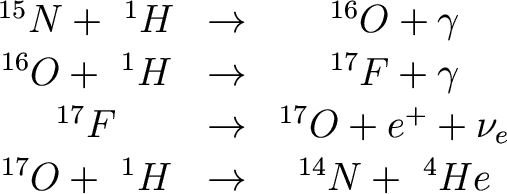
Question: Why do we need high temperatures and pressures?
As we learned, when you fuse 4 hydrogen atoms together to make 1 helium atom, you create 26.7 MeV of energy.
The energy production rate due to the p-p chain depends on temperature. At the temperatures in the interior of the Sun,
While that looks like a strong dependence, just hold on....

So you end up turning 4 H into 1 He. All other nuclei are conserved.
But every once in a while (0.04% of the time), the CNO cycle branches off:

How does the energy generation rate in the CNO cycle depend on temperature? Again near the temperatures of the center of the Sun, it goes like this
Wow. A very strong temperature dependence. What does this
mean?
In stars of the sun's mass and below, the p-p cycle is
more efficient (temperature is too low for the CNO cycle to run efficiently).
But in more massive stars the central temperature is higher (why?). The
higher central temperatures boost the efficiency of the CNO cycle faster
than that of the p-p cycle, and CNO begins to
dominate in stars slightly more massive than the Sun.